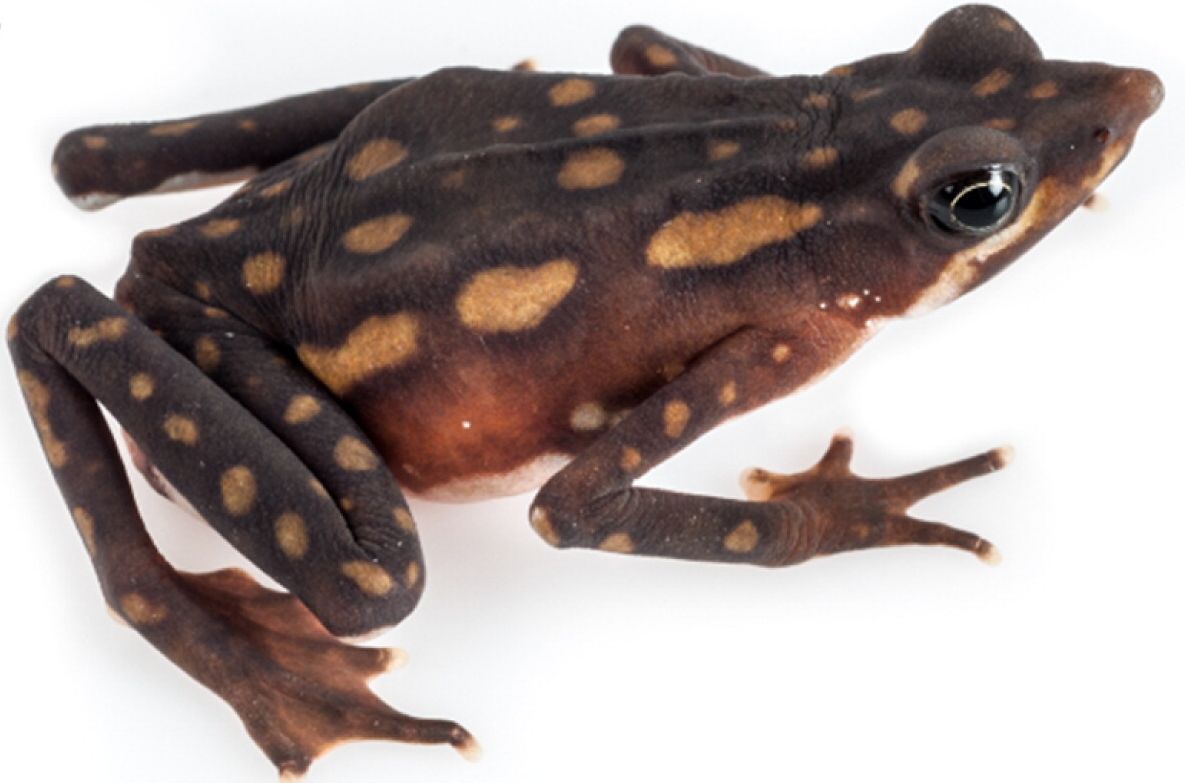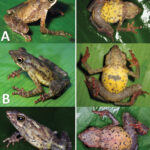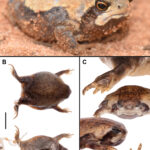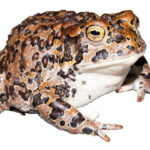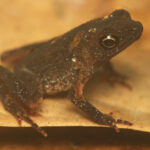Atelopus longirostris: Unveiling the Secrets of Ecuador’s Enigmatic Harlequin Frog#
Hidden among the lush vegetation and crystalline streams of Ecuador’s pristine cloud forests resides an amphibian whose survival holds broader ecological revelations: the Atelopus longirostris. Commonly known as the Longnose Harlequin Frog, this species transcends its small size with vibrant coloration, intriguing behaviors, and a fierce battle against extinction.
With its distinctive elongated snout and vivid patterns, the Longnose Harlequin Frog immediately captivates naturalists and researchers alike. Yet beneath its aesthetic charm lies a story of resilience, adaptability, and ecological significance waiting patiently—and perhaps urgently—to be told.
Taxonomy and Classification#
The Longnose Harlequin Frog, Atelopus longirostris, is a member of the Bufonidae family, specifically within the genus Atelopus, which comprises a group known as Harlequin toads. Harlequin toads are distinguished by their remarkably diverse patterning and coloration, typically signaling their toxicity to potential predators—a classic example of aposematic coloration in nature.
Originally described by Cope in 1868, Atelopus longirostris received its specific epithet, longirostris, from Latin meaning ‘long-snouted,’ a nod to its unusual facial structure that prominently distinguishes it from closely related species such as Atelopus elegans. Such markers are integral to understanding the evolutionary lineages and adaptive specialization this frog exhibits.
Natural Habitat#
Geographic Distribution#
Once widely scattered throughout Ecuador’s vibrant cloud forests, particularly on the western slopes of the Andes, Atelopus longirostris has historically flourished along a narrow altitudinal band ranging roughly from 200 to 1,800 meters above sea level. Habitats in the regions around Cotopaxi and the Chocó Bioregion have been particularly significant, providing essential microhabitats ideal for reproduction, foraging, and shelter.
Cloud Forest Ecosystems#
The Longnose Harlequin Frog’s favored environment is intricate and breathtakingly beautiful. Cloud forests are enchanting ecosystems enveloped in perpetual mist, richly carpeted in moss and ferns, fabled for their diverse and delicate biodiversity. Here, emerald-draped tree branches arch over crystalline streams, sheltering vibrant ecosystems beneath their shaded canopies.
Within these environments, Atelopus longirostris thrives near clear, fast-flowing mountain streams, essential not just for hydration but also for their reproductive needs. This setting provides the exact humidity, stable temperature regimes, and ample insect prey necessary for their survival. Moreover, the pristine waters facilitate tadpole development, increasing the prospects of future generations.
Physical Characteristics#
A first glance at the Longnose Harlequin Frog reveals an almost unparalleled beauty among amphibians. Typically ranging from a modest 2.5 to 4 centimeters in length, these diminutive creatures wear a tapestry of contrasting colors, characterized by bright yellows, greens, and oranges interwoven with stark blacks and browns. Each individual showcases unique patterns, ensuring no two look exactly alike—much like fingerprints.
The elongated facial feature, or “long snout,” is the most distinctive trait setting it apart from other Harlequin frogs. Experts believe this adaptation helps the frogs effectively forage and avoid predation by subtly enhancing their camouflage within leaf litter and stream margins, where shadows and shapes play an elaborate game of hide and seek.
The skin of Atelopus longirostris exudes mild toxins—an evolutionary staple stemming from their diet of toxic insects, serving as an effective deterrent to predators. This intricate chemical arsenal is advertised boldly through their vibrant coloration, a classic instance of nature’s ingenious warning systems at play.
Behavior and Life Cycle#
Feeding Habits and Daily Rhythms#
Impressive for its size, Atelopus longirostris is a voracious predator of small invertebrates, chiefly insects and spiders. During the humid mornings and twilight hours, it deftly navigates microhabitats of mossy rocks and ferns, utilizing its long, slender tongue with swift precision to capture prey. Their dietary preferences significantly shape their internal chemistry and indirectly influence their survival strategies in the wild.
Mating and Reproduction#
During the brief rainy seasons, male Longnose Harlequin Frogs congregate near rushing streams and emit gentle yet distinctive calls to announce their presence to potential mates. The songs are soft, resembling quiet chirping or clicking, which cleverly balance attraction with predator avoidance.
Upon successful courtship, females deposit clutches of pearlescent, gelatinous eggs submerged in clear, clean water flows. Afterward, diligent parental care remains limited, compelling nature to guide the vulnerable tadpoles through their transformation from aquatic larvae to terrestrial juveniles—a precarious journey filled with potential peril.
Ecological Role#
Despite their small stature, Atelopus longirostris plays a substantial role as both predator and prey within their niche ecosystem. Feeding primarily on insects, they contribute to regulating arthropod populations, thus aiding natural balance. Conversely, predators such as snakes, birds, and small mammals rely on these amphibians as a critical dietary component, tying Longnose Harlequin Frogs firmly into complex food web dynamics.
Furthermore, as sensitive amphibians, their health and presence serve as crucial bioindicators, reflecting the ecological status of their habitats. Changes in their population swiftly alert ecologists to environmental shifts—pollution, climate alterations, or habitat degradation—making this frog an invaluable sentinel species within its cloud forest refuge.
Threats and Conservation Status#
Regrettably, alarm bells have rung loudly concerning Atelopus longirostris. Classified by the International Union for Conservation of Nature (IUCN) as Critically Endangered, this species faces imminent threats mainly driven by habitat destruction, climate change, and the invasive disease chytridiomycosis—a fungal infection decimating amphibian populations globally.
Deforestation and expanding agriculture continuously encroach on their narrow habitat corridors, ironically placing immense pressure on ecosystems that safeguard this frog’s survival. Climate shifts destabilize seasonal patterns, disrupting breeding cycles and moisture levels critical for successful egg and tadpole emergence.
Resilience efforts by dedicated conservationists include targeted habitat preservation, careful monitoring programs, captive breeding initiatives, and broader awareness campaigns designed to elevate the species’ profile and emphasize its ecological significance. Collaboration between local communities, governmental agencies, and international conservation bodies remains crucial for any hope of recovering viable populations.
Cultural and Scientific Significance#
Beyond biological curiosity, Atelopus longirostris has left a subtle imprint upon indigenous culture and scientific inquiry alike. Various Andean indigenous communities hold frogs symbolically sacred, often associating their presence with water purity and ecosystem health, thus underscoring traditional respect toward habitat conservation ethics deeply rooted in cultural beliefs.
From a scientific perspective, the frog’s delicate physiology offers contemporary biologists insights into environmental cleanliness, bioindicators, disease ecology, and toxicology. Each strand of research spun from this creature’s natural history contributes uniquely to a richer scientific tapestry, advancing our comprehension of biodiversity and ecosystem interdependencies.
Conclusion#
With its captivating aesthetics and instructive ecological narratives, the Longnose Harlequin Frog compels a narrative beyond simple amphibian interest. It serves as a clear illustration of our interconnected relationship with nature, an emblem of biodiversity’s fragility, and a beacon indicating our global environmental health.
As advocates, naturalists, or simply fascinated observers, our collective responsibility lies in amplifying awareness, supporting conservation initiatives, and respecting habitats crucial to species survival like that of the Atelopus longirostris. Only by recognizing and embracing these natural connections will we safeguard not only the enigmatic Longnose Harlequin but also the diverse fabric of life itself.

